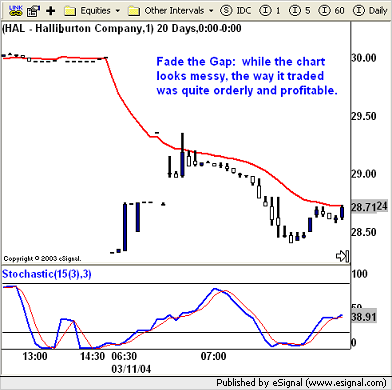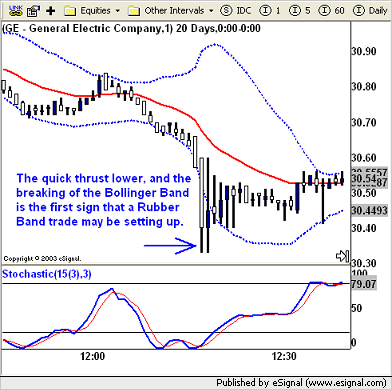These Trades Are Working Now
Long-time readers know
that my #1 Rule is to trade with trend. The trend being defined by
the slope of the 20 period moving average on a 1-minute chart. However, like
all things in life rules can and need to be broken in order to make headway, or
in our case; profits.
I have mentioned in recent articles that I have
doing a lot of Fade the Gap type trades
lately. These trades are completely counter-trend. What I have been a bit lax
on is reviewing the characteristics of these trades so that it is more clear to
everyone. Since it is not mentioned in my book, it deserves some attention,
rather than the a simple “Hey, these trades worked great yesterday.”
Let’s go back and take a look at the trades I
mentioned in Friday’s article, Fade the Gap
and Rubber Band trades.
Fade the Gap originated from the price action
that occurred when a stock opened far above/below the previous day’s closing
price. The logic was that all stocks, like most things in life, when out of
equilibrium will, to some extend, regress back towards a central point, call
reversion to the mean. Similar to the way a rubber band goes back to its’
original shape when stretched too far. A specialist will typically open a stock
at a price where he/she believes is the present “equilibrium price” and where
there is the greatest possibility of the stock moving back in the opposite
direction. Remember, a specialist needs to take the other side of a trade, so
when there is large buying/selling interest on the opening, they are on the
other side. Naturally if the specialist is selling stock to all the buyers on
the opening (getting short), he/she are betting that the opening price will be
pretty close to the top print for that time, and they will profit from any move
lower. The opposite applies when the specialist has to be the buyer when
confronted with a bunch of sell orders on the opening.
While these trades are easily identified on the
opening, they can occur during the trading day as well. Again, it is really
just a function of a stock falling/rising in a rapid manner as well as it
losing/gaining a lot of ground in that time.
Both of these trades combine two skill sets:
1. Your ability to determine if the stock is
overbought/oversold as defined by the stochastics.
2. Tape reading
You need Step 1 to be verified before you can
proceed to Step 2. Step 2 is the most critical. There are no books on it and
proficiency in it comes from old fashioned staring and repetition, something
most traders never choose to do. Simply buying or selling a stock cause it is
oversold can be costly. Tape reading really boils down to observing price
action and trying to determine when the price is about to make that
counter-trend move. The common things I look for are bids or offers that do not
go away despite lots of trades occurring at that price or simply showing
up-ticks on large volume in the opposite direction. Again, it is an art, but
can be learned. The most accomplished traders in my
Trading Room are those who understood from day 1 that it was going to
take a month or two of observing a handful of stocks before they could really
have that level of understanding that allowed for anticipation rather than
reaction. Believe it or not, knowing when to pull the trigger on just about any
trade set-up comes from the gut, the synthesis of your technical abilities and
your ability to have focused on tape reading, it really becomes a sub-conscious
understanding, as it should. The market cannot be boiled down to a standard set
of rules in order to be successful. Rules, as mentioned above, are a
requirement, but really a small piece. The market consists of humans making
decisions based on fear and greed, you cannot quantify that fully with standard
technical analysis. It is your job to be able to dig deeper and use your skills
in observation in order to make a decision as to what is really going on. This
is the heart of knowing when to execute a Fade the Gap
/ Rubber Band Trade.



The Altria
(MO) trade as you see was the one that really required tape reading. For
several bars the stochastics remained oversold, yet the price action grinded
lower, a costly mistake for a trader relying solely on technicals. The only
thing that allowed for the proper entry here was tape reading.
As we all know the market is demanding, now more
than ever. The forgiving intra-day volatility of years ago is gone, there are
trades each and everyday, you just need to have the patience and skill set to
take advantage of them. remember, trading is a marathon, not a sprint.
As always, feel free to send me your comments and
questions.
